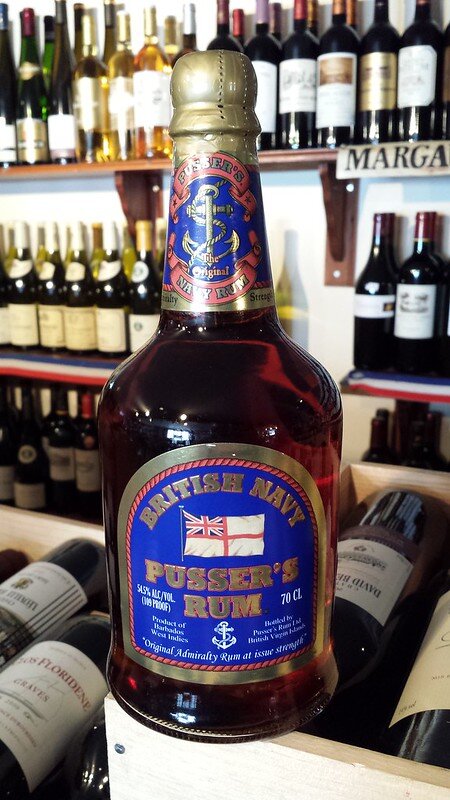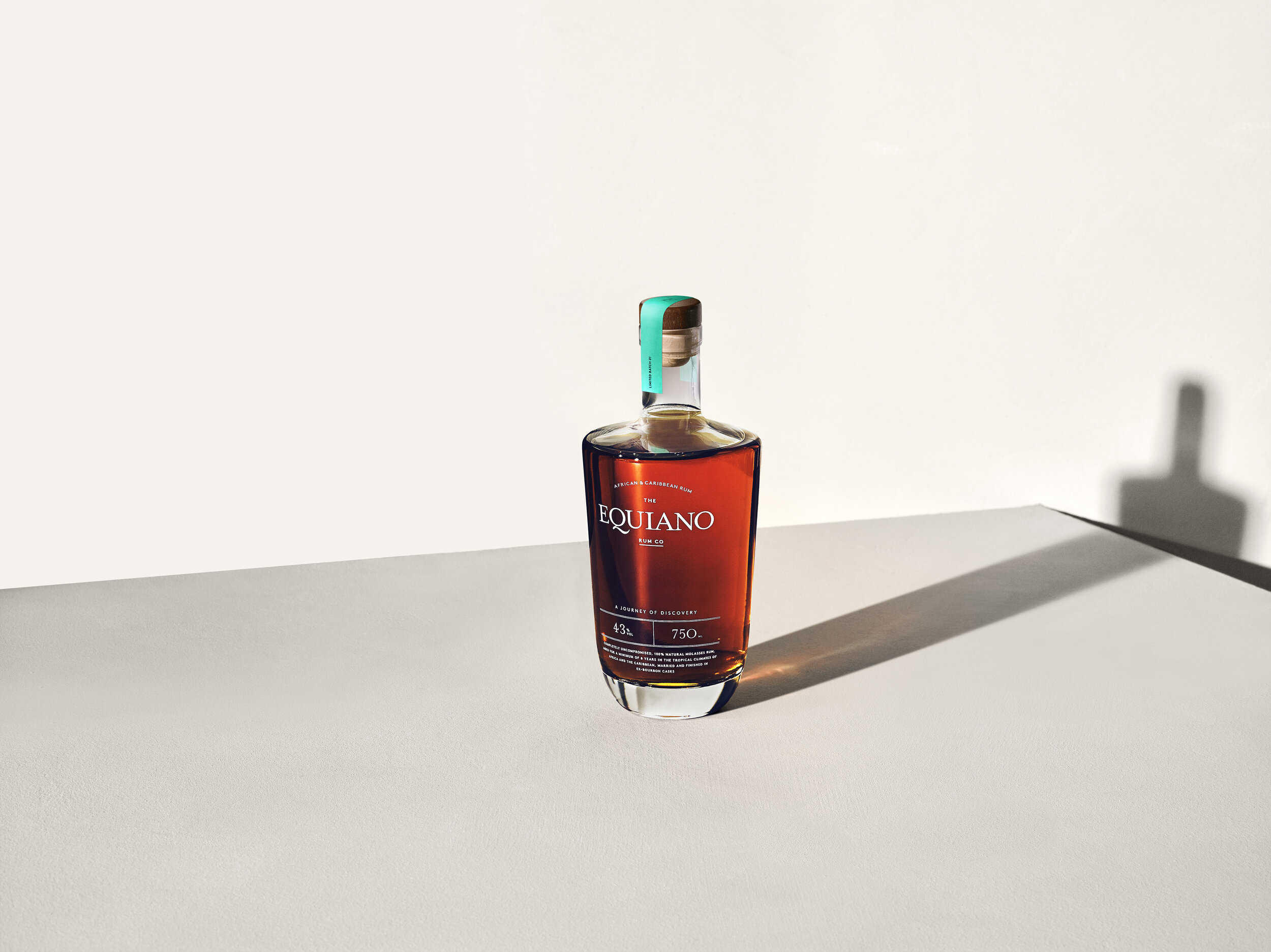Up Spirits! The Rise and Fall of the British Rum Ration
Rum Rationm Aboard HMS King George V, 1940, credit Lt. S. J. Beadell
July 31 marks the 50th anniversary of the end of the naval rum tot ration
Picture this: It is late in the morning at the office, and the staff is hard at work. Between 11 AM and noon, a Slack message goes out to the #general channel "Up Spirits!" with a little glass emoji. Everyone heads to the break room, where a member of Human Resources is doling out the daily tot of rum. They are serving a half-pint (8 oz./ 237 mL) of 54.5% ABV (95.5 proof) of tropical happiness. It is to be enjoyed while there, no sipping or taking it back to a desk. Once the half-pint of rum is drained, each member of the team heads back to work.
How is that possible, while still maintaining productivity? Over time, the staff gets used to it, considering that it is something they will be receiving every day. Why? Because it is one of the safest, most economical options for them to drink. While this may seem like sheer insanity, this was a reality for the British Navy, and many other navies, until 1970. The tot was retired on what is now known as Black Tot Day: July 31, 1970.
Royal Navy Grog, via Wikipedia
Why the ration?
When the British Navy introduced rum and other hard liquors in the mid 17th century, it was a much better idea than it sounds today. At the time, the British Empire was expanding. They had colonies all over the world, from the American colonies to Africa to India. Travel to the colonies from this island nation took a long time. Arriving at the east coast of America could take as long as six weeks, depending on the ship’s size and where the ship was planning to land. These long journeys meant that the British were always looking for better ways to improve what the sailors had to eat and drink to keep them happy and healthy on their voyages. Before rum, sailor drinking options were either beer that typically soured on the journey or water from land that went bad. (see footnote 1) If they were from London, that meant the Thames. Not the cleanest source of water in the world.
They found a solution when they started going to Jamaica and the Caribbean for sugar. They took the island from the Spanish in 1655 acquiring control of the sugar industry. This new resource brought them access to the rum, or rumbullion, that was distilled there at the time. They discovered a few things about the rum that made it the superior choice in the minds of the British. Due to the higher alcohol content, it was not as susceptible to spoilage on the months-long voyages. The ration of beer on a trip was a gallon of beer per day. With rum, they could reduce the amount of cargo they had to carry for rations since they were giving much less rum per person than beer. (see footnote 2) However, they did not anticipate the problems they were going to have with very, very drunk sailors.
Admiral Edward "Old Grog" Vernon was not a fan of the foolishness of drunken sailors. He knew what to do with a drunken sailor early in the morning; cut their ration. When he took over monitoring the British Navy in the 1740s, one of the first things he did was split the daily 8 oz./ 237 mL ration. Sailors now received 4 oz./ 118 mL at the standard time in the morning, and another ration around dinner time. Admiral Vernon watered down the tot of rum as well, so it was a four to one ratio of water to rum. The sailors, unhappy with this turn of events, started to refer to the mixture as grog. By 1760, lime juice and sugar were added to the mix to keep the sailors healthy, making the ration taste better but still more diluted. When neither of these were enough to keep them somewhat sober, the sailors knew flogging was the punishment for drunkenness. (see footnote 3) What would the drink be like that the sailors enjoyed? It might look something like this:
18th Century-style Grog
1.5 oz./ 44 mL Pusser’s Gunpowder Proof Rum
1 oz./ 30 ml lime juice
2 tbsp/ 24 g sugar, as unprocessed as you can find (demerara would be most common)
6 oz./ 177 mL room temperature water
Glass: Tall
Ice: None
Garnish: None
Pour all of the ingredients into a glass. Stir until the sugar is dissolved.
In this cocktail, the ratio of water to rum is the ratio that Admiral Vernon prescribed. The lime juice, with two tots a day, would be enough citrus through the week to fulfill the experimental amount James Lind discovered was enough to keep scurvy at bay. The sugar, added for taste, would be as close to the unrefined sugar you would find at that time. If you want to make it into a proper cocktail, pour the rum, juice and sugar into a shaker over ice. Shake well for at least fifteen seconds or until the tin is cold on the outside. Strain over fresh ice into a tall glass, then topped with chilled water. This version may be more familiar to the modern palate.
Pusser’s Rum, photo Dominic Lockyer
Experience may vary
Contrary to popular opinion, rum was not the immediate standard for the whole Navy. For many years, a mixture of different liquors were on different ships, depending on where in the empire they were stationed. The sailors near India had arrack. Those sailing the Atlantic could find their hold filled with brandy or gin. A blog by Cocktail Wonk (Matt Pietrek) notes "that the British navy purchased 625,000 gallons of brandy, and only 250,000 gallons of rum" in 1805. Spirits other than rum had their unique challenges. Due to the fluid nature of the wars in Europe, getting supplies from France or the Netherlands could be problematic. Furthermore, arrack, while readily available, was not enjoyed by the sailors. They preferred other things to drink that the native spirit of India. Early in the 19th century, however, rum was made the official drink of the British Navy around the world, brought to England, aged briefly, and shipped to where it was needed. (see footnote 4)
The ceremony for serving the rum to the sailors was a simple one. The boatswain would play the "Up Spirits!" notes on his whistle, and the sailors would gather on a deck where they rolled out the Rum Tub. Every sailor would receive a ration of rum in a glass unwashed on the inside. An old yarn insisted that the rum built up on the inside of the glass, seasoning it and improving the taste and potency of the rum over time. They would enjoy their tot, hand it back to the Purser (the slang term for the position being "Pusser," as in the rum), and return to their station. If they were underage, there was no ration of rum. As time passed and the temperance movement started to sweep the world, they could also choose a bonus of three pence instead of their tot of rum. (see footnote 5) Alternatively, they could take their rum and pass it to another sailor as a favor. On a ship that is out to sea for weeks, rum became a bartering tool and a benefit of service.
The end of the tot
Changes during the 19th century laid the groundwork for removing the tot. In 1823 the rum ration was entirely cut in half to 4 oz./ 118 mL per day, then cut in half again to 2 oz./ 60 mL. The temperance movements were building through the world, and improving technology was making the workplace hazardous. With the massive technological leaps in wartime technology in the two World Wars, ships were complex machines to run. Buzzed sailors could cause massive problems. This concern led to a review of the tot policy, and Second Sea Lord and Chief of Naval Personnel Peter Hill-Norton to propose its abolishment in 1967. HIs proposal, after much debate, was finalized on December 17, 1969. The tot's proposed replacement was a bar on the ship run by senior staff. The change was to take place in 1970. (see footnote 6)
To say that the rank and file personnel of the British Navy were unhappy would be an understatement. They enjoyed their ration of rum, the break in the day, and the quick assembly with other people on their ship. If they did not drink, the extra money in their paychecks. However, they all dutifully accepted the change. The final day of rum tots saw various solemn ceremonies. Some ships, like the HMS Minerva, gave the Rum Tub a twenty-one gun salute when tossing it into the briny deep. The crew of the HMS Jufair, ashore at the time, took their Rum Tub on land and buried it, complete with a ceremony and headstone. (see footnote 7)
The final tot was served on the HMS Fife while docked in Pearl Harbor. According to an article written by the Royal Navy Writers Association, pipers played a dirge as the Rum Tub made its way to the ship's stern. The burial at sea of the tub received such a ceremony that a passing Japanese ship's crew saluted it as if it were a person, not a ritual heading to the Pacific Ocean's bottom.
courtesy Equiano Rum
Rums for Black Tot Day
If you want to toast Black Tot Day, here are some ideas for rums that would hit the right notes — starting with the appropriately named Finest Caribbean Black Tot, a rum blend from Guyana, Barbados, and Jamaica. This rich, 46.2% ABV rum sells for $60. Pusser’s Gunpowder Strength sits at the official 54.5% ABV required by the Royal Navy. For $32, this rum that hails from Guyana can be part of your collection. From Mauritius and Barbados, the limited production Equiano Rum (co-founded by Global Rum Ambassador and rum historian Ian Burrell) embraces the natural beauty of the spirit at 43% ABV for $60 a bottle. Until August 23rd, you can get 10% off by purchasing a bottle here (use code TASTELIVE), and on August 6th, join Ian Burrell for a live Facebook tasting here. While in Barbados, consider the classic The Real McCoy 12 Year Aged Rum. A bottle of this 40% ABV rum will fit nicely into a collection for $60. From Belize, NY International Spirits Competition award-winning Copalli Rum. Their organic white rum, available online for $25, falls in line with many other rums in this list at 42% ABV. From sunny California, Cutwater Spirits Three Sheets (another NYISC winner) cask-strength rum offers a hefty ABV, typically around 64%, at about $90. Massachusetts, a significant rum producer in colonial times, puts out Privateer Navy Yard Rum for $50. At barrel-strength, its ABV is going to vary but hovers around 55%.
The ceremony on the HMS Fife was the end of a three centuries-old tradition. A tradition that borne of necessity ended from the same necessity; keeping the sailors in the British Navy safe. With the technology we use every day becoming increasingly sensitive, and the possession of deadlier weapons, the removal of rum shots twice a day was an excellent idea. The need for a stable drinking ration for sailors had long since passed. The trip from Britain to America, even by ship, is now about a week. In the name of tradition, we raise a glass to celebrate its impact.
Perhaps this time not while we’re working.
References
1 Fighting Spirits - Three Centuries of Rum in the Royal Navy 2013
2 The History of Jamaica 2019
4 How Pusser's rum became the official drink of the British Royal Navy 2018




